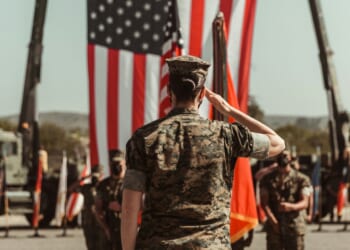The United States has built almost all of the world’s most expensive aircraft—typically for niche roles such as stealth bombing or electronic warfare.
Modern military aircraft are engineering marvels—combining stealth, supermaneuverability, and advanced data fusion. But these technological leaps come at a steadily growing price. As capabilities expand, costs rise in lockstep, making today’s military aircraft among the most expensive machines ever built. 10 aircraft in particular stand out for their soaring price tags, ranked in ascending order according to unit flyaway cost per aircraft in current USD. It should be noted that this is simply the cost of the aircraft itself, and some of the aircraft on this list have sharply higher costs per flight hour than others.
If you look closely, you’ll see a trend in aircraft pricing that speaks to a broader truth in the world’s military-industrial landscape: nine of these 10 aircraft are American in origin. Despite its defense industrial base’s many problems, the United States is peerless in terms of quantity and quality of military-industrial output.
10. F-35 Lightning II (Fighter Jet)
Unit cost: $115-130 million

- Year Introduced: 2015
- Number Built: Over 1,000 (as of 2025)
- Length: 51 ft 4 in (15.7 m)
- Wingspan: 35 ft (10.7 m)
- Weight (MTOW): 70,000 lb (31,800 kg)
- Engines: One Pratt & Whitney F135-PW-100 afterburning turbofan
- Top Speed: ~1,200 mph (1,930 km/h) / Mach 1.6
- Range: ~1,380 mi (2,220 km) with internal fuel
- Service Ceiling: 50,000 ft (15,240 m)
- Loadout:
- One GAU-22/A 25 mm rotary cannon (internal on F-35A only)
- Internal bays: Up to four AIM-120 AMRAAMs, or two bombs and two AMRAAMs
- External hardpoints: Up to 18,000 lb (8,160 kg) of ordnance (compromises stealth)
- Aircrew: 1
It might surprise some that the F-35 Lightning II—notorious for its massive budget overruns—comes in at only number 10 on the list. Despite a rocky start, the F-35 has become more economical over time; it is the most produced fifth-generation fighter in the world, lowering per-unit costs and cementing the platform as the centerpiece of modern Western air power.
Designed and built by Lockheed Martin as a single multirole platform for the Air Force, Navy, and Marine Corps, the F-35 comes in three variants—one conventional, one carrier-based, and one with vertical / short takeoff and landing (VSTOL) capabilities. The F-35’s advanced stealth shaping, its advanced AN/APG-81 AESA radar, and its best-in-class data fusion make it an unrivaled sensor hub.
9. Eurofighter Typhoon (Fighter Jet)
Unit cost: $180-200 million

- Year Introduced: 2003
- Number Built: 609 (+ 7 prototypes)
- Length: 15.96 m (52 ft 4 in)
- Wingspan: 10.95 m (35 ft 11 in)
- Weight (MTOW): 23,500 kg (35,274 lb)
- Engines: Two Euroject EJ200 afterburning turbofan engines, 60 kN (13,500 lbf) thrust each dry
- Top Speed: 2,495 km/h (1,550 mph) / Mach 2.35
- Combat Radius: 1,389 km (863 mi)
- Service Ceiling: 16,764 m (55,000 ft)
- Loadout: One 27mm Mauser BK-27 revolver cannon; 13 hardpoints (8 under wing, 5 under-fuselage pylon stations); 9,000 kg (19,800 lb) total payload capacity
- Aircrew: 1-2, depending on variant
A cornerstone of European air power, the four-nation Eurofighter Typhoon combines agility, speed, and multirole capability. Designed for air superiority but optimized for strike missions, too, it features advanced AESA radar, infrared search-and-track, and a digital flight control system.
The Typhoon’s twin-engine design gives it exceptional thrust-to-weight performance and maneuverability. Although it is technically a fourth-generation fighter, continuous radar and avionics upgrades have kept it relevant well into the fifth-generation era—marking it as one of Europe’s primary industrial successes.
8. P-8A Poseidon (Maritime Patrol Aircraft)
Unit cost: $200 million
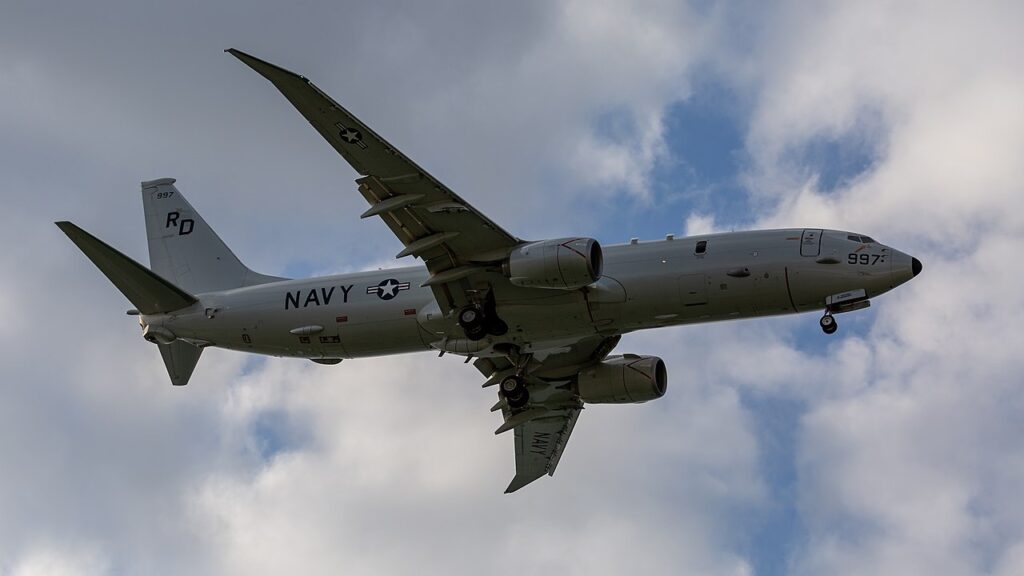
- Year Introduced: 2013
- Number Built: 160+ delivered to US Navy; 200+ worldwide, including US allies (Australia, India, UK, Norway, etc.)
- Length: 129 ft 6 in (39.47 m)
- Wingspan: 123 ft 6 in (37.64 m)
- Weight (MTOW): ~189,200 lb (85,820 kg)
- Engines: Two CFM International CFM56-7B27A high-bypass turbofans (~27,300 lbf thrust each)
- Top Speed: ~564 mph (907 km/h)
- Range:
- Combat radius: ~1,200 nmi (2,222 km) with 4 hours on station
- Ferry range: ~4,500 nmi (8,300+ km)
- Service Ceiling: 41,000 ft (12,500 m)
- Loadout: 11 internal weapons stations (bomb bay + underwing pylons); can carry torpedoes, naval mines, depth charges, Harpoon anti-ship missiles; total payload capacity unknown
- Aircrew: 9 (2 pilots, 7 mission crew)
Adapted from the popular Boeing 737-800 airframe, the P-8A Poseidon is a maritime patrol and anti-submarine warfare aircraft. Outfitted with advanced radar, electro-optical sensors, and sonobuoy launchers, it can track submarines, ships, and surface targets across vast ocean areas—and it likewise comes equipped with torpedoes, depth charges, and anti-ship missiles for engaging them.
The P-8 is networked with US and allied naval forces for integrated surveillance and strike operations—a key feature as the US pivots its attention towards the Indo-Pacific.
7. E-2D Advanced Hawkeye (Early Warning Aircraft)
Unit cost: $220 million

- Year Introduced: 2014 (E-2D Advanced Hawkeye IOC; E-2 family first flown/service in 1964)
- Number Built: ≈75 E-2D airframes procured for the US Navy; several hundred E-2s across all variants historically
- Length: 57 ft (17.4 m)
- Wingspan: 80 ft (24.4 m); foldable wings for carrier storage
- Weight (MTOW): ≈56,000 lb (≈25,400 kg)
- Engines: Two Rolls-Royce T56-A-427A turboprops (~5,100 shp each)
- Top Speed: ≈350 knots (≈403 mph, ≈648 km/h) max; cruise ≈300 knots (≈345 mph, ≈556 km/h)
- Range: Ferry/long-range ~1,500 nmi (≈1,726 mi, ≈2,778 km); on-station endurance measured in many hours (mission-dependent)
- Service Ceiling: ≈34,000 ft (≈10,363 m)
Loadout: No weapons carriage as primary role; mission systems include large dorsal rotodome (~24-ft radome) housing AN/APY-9 radar, electronic surveillance, CEC/Link-16 datalinks, and multiple mission consoles for battle-management and sensor fusion - Aircrew: Typically 5 (2 pilots + 3 mission systems/operators)
The E-2D Advanced Hawkeye, built by Northrop Grumman for the US Navy, serves as America’s primary carrier-based airborne early-warning and control aircraft. Distinctive for its spinning rotodome radar, the twin-engine turboprop provides 360-degree surveillance, command, and control for carrier strike groups.
The E-2’s new D-variant introduces the APY-9 radar, with electronic scanning and maritime tracking capability, a glass cockpit, and networked data links that integrate seamlessly with surface vessels and the F-35. Although compact, the E-2D serves as the Navy’s aerial command post, extending detection range and coordination for the entire fleet.
6. NE-7A Wedgetail (Early Warning Aircraft)
Unit cost: $230-250 million

- Year Introduced: 2009 (Royal Australian Air Force service)
- Number Built: ~14 delivered worldwide; >25 planned for the U.S. Air Force and other allies
- Length: 110 ft 4 in (33.6 m)
- Wingspan: 117 ft 5 in (35.8 m)
- Weight (MTOW): 171,000 lb (77,565 kg)
- Engines: Two CFM International CFM56-7B27A turbofans (~27,000 lbf thrust each)
- Top Speed: ~530 mph (460 knots, 850 km/h)
- Range: >3,500 nautical miles (~6,500 km); ~10 hours’ endurance (unrefueled)
- Service Ceiling: 41,000 ft (12,500 m)
- Loadout: No offensive weapons; Northrop Grumman Multi-role Electronically Scanned Array (MESA) radar—top-mounted “top hat” antenna, 360° coverage, multi-target tracking at ranges >200 nautical miles; IFF system, ESM suite, data links (LINK 16 and beyond), secure communications and battle-management consoles
- Crew: 2 (flight) + 10–12 mission operators (typical)
The E-7 Wedgetail is a next-generation airborne early-warning and control platform built by Boeing from its 737-700 airframe. Equipped with Northrop Grumman’s MESA radar, mounted on top of the fuselage, with an electronically scanned antenna providing 360-degree coverage at long range. The E-7 can simultaneously track hundreds of airborne and surface targets while directing fighter operations and battle management.
The E-7A is currently in operation with Australia, South Korea, and Turkey—with the US and UK slated to procure the jet soon.
5. SR-71 Blackbird (Surveillance Aircraft)
Unit cost: $270 million (adjusted for inflation)

- Year Introduced: 1966
- Number Built: 32, not including prototypes
- Length: 107 ft 5 in (32.74 m)
- Wingspan: 55 ft 7 in (16.94 m)
- Weight (MTOW): ~170,000 lb (77,111 kg)
- Engines: Two Pratt & Whitney J58 turbojet/ramjet-mode engines (~32,500 lbf / 144.6 kN thrust each with afterburner)
- Top Speed: Mach 3.3+; absolute recorded speed ~2,193.17 mph (3,529 km/h)
- Range: ~2,900 nmi (~3,337 mi, ~5,371 km) ferry; mission range varies with refueling
- Service Ceiling: ~85,000 ft (~25,900 m)
- Payload: Strategic reconnaissance — high-resolution optical cameras, infrared sensors, side-looking airborne radar (SLAR), ELINT/COMINT suites; no offensive armaments
- Aircrew: 2 (pilot and reconnaissance systems officer)
Arguably the most iconic aircraft ever built, the SR-71 was a true technical marvel, generations ahead of its contemporaries. Crafted largely from titanium to withstand the heat of Mach 3+ flight, the SR-71 operated above 80,000 feet and was so fast that it could outrun the surface-to-air missiles that were fired at it.
Developed in secret at Lockheed’s experimental “Skunk Works” division during the 1960s, the SR-71 personified the Cold War like few other aircraft, operating behind enemy lines to collect intelligence with relative impunity—too fast and too high to defend against. Ultimately, the advanced aircraft was done in by the end of the Cold War, and the advent of satellites capable of fulfilling its mission from space.
4. F-22 Raptor (Fighter Jet)
Unit cost: $350 million
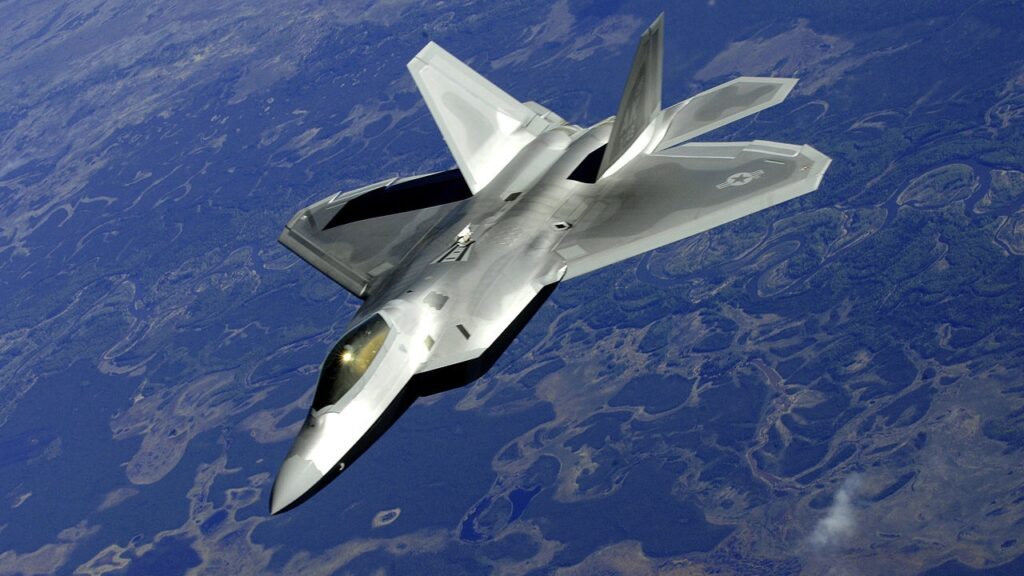
- Year Introduced: 2005
- Number Built: 195 (including eight test aircraft)
- Length: 62 ft 1 in (18.9 m)
- Wingspan: 44 ft 6 in (13.6 m)
- Weight (MTOW): 83,500 lb (37,900 kg)
- Engine: Two Pratt & Whitney F119-PW-100 turbofans with thrust vectoring
- Top Speed: ~1,500 mph (2,414 km/h) / Mach 2.25
- Range: ~1,839 mi (2,960 km) with internal fuel
- Service Ceiling: 65,000 ft (19,812 m)
- Loadout: M61A2 20 mm rotary cannon; up to six AIM-120 AMRAAMs and two AIM-9 Sidewinders in internal bays; external hardpoints
- Aircrew: 1
The F-22 is the world’s premier air-superiority fighter. Designed by Lockheed Martin at the turn of the century and introduced in 2005, the F-22 was a full generation ahead of its competition, and will likely still be the king of air-to-air combat capabilities even at the time of its retirement.
The F-22 boasts two Pratt & Whitney F119 engines, supercruise, and thrust-vectoring-enabled supermaneuverability. With the AN/APG-77 AESA radar, advanced sensors, and data fusion, the F-22’s pilot is granted exceptional situational awareness. The production line ended in 2012, after just 187 aircraft had been built—meaning the per-unit cost has remained staggeringly high.
3. B-21 Raider (Stealth Bomber)
Unit cost: $750-800 million (estimated)
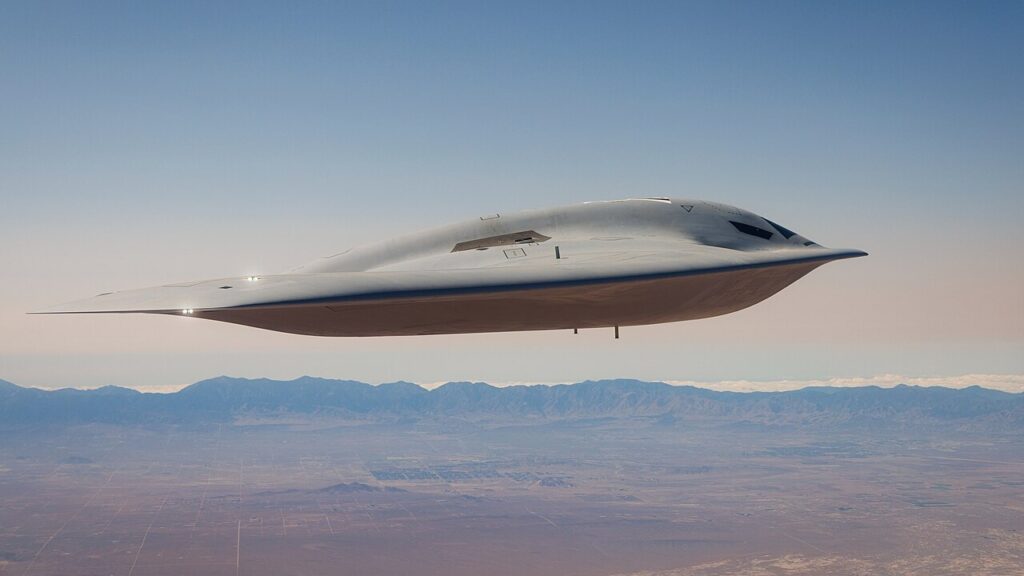
- Year Introduced: Prototype phase (expected introduction 2027)
- Number Built: 3 (prototypes)
- Length: 54 ft (16 m)
- Wingspan: 132 ft (40 m)
- Weight (MTOW): 180,000 lb (81,647 kg)
- Engine: Unknown
- Top Speed: ~600 mph (965 km/h) / Mach 0.8
- Range: Unknown
- Service Ceiling: 50,000 ft (15,000 m)
- Loadout: One primary weapons bay with a capacity of 20,000 lb (9,100 kg) weapon load; can carry AGM-181 LRSO, JDAM family of munitions
- Aircrew: 2
The B-21 Raider hasn’t been released yet. But the replacement to the B-2 Spirit, a next generation strategic bomber, promises to be one of the world’s most expensive aircraft.
Built by Northrop Grumman, the B-21 was designed with relative affordability in mind—at least when compared to its predecessor. There is no cheap way to build a stealth aircraft; the cutting-edge stealth shaping and digital architecture that their construction involves invariably come with a steep price tag. Designed for both nuclear and conventional strike missions, the B-21 is expected to be capable of penetrating advanced air defense systems—giving the United States a formidable nuclear triad.
2. VC-25B (Air Force One)
Unit cost: $1.9 billion

- Year Introduced: 1990
- Number Built: 2 (Tail numbers 28000 and 29000)
- Length: 231 ft 10 in (70.67 m)
- Wingspan: 195 ft 8 in (59.64 m)
- Weight (MTOW): ~833,000 lb (378,000 kg)
- Engines: Four Pratt & Whitney JT9D-7R4G2 turbofans (~56,700 lbf each)
- Top Speed: ~575 mph (925 km/h)
- Range: Unlimited with aerial refueling; ~7,800 nmi (8,976 mi, 14,445 km) unrefueled
- Service Ceiling: ~45,000 ft (13,700 m)
- Loadout: Secure communications suite, EMP hardening, aerial refueling, defensive countermeasures, medical bay, presidential suite, conference and staff sections
- Aircrew: Typically 4 flight crew; up to ~70–100 total personnel (staff, security, press)
The VC-25B—known as “Air Force One” when used as the presidential aircraft—is the forthcoming generation in that role, based on the Boeing 747-8 platform. Far more than a simple transport jet, the VC-25B is a hardened flying command center capable of ensuring the continuity of government during a crisis. Each aircraft includes secure communications, electronic countermeasures, self-protection systems, and a fully equipped presidential suite. Currently, two VC-25Bs are being built by Boeing—each with the world-class safety, security, and communications features appropriate for a head of state.
1. B-2 Spirit (Stealth Bomber)
Unit cost: $2.1 billion
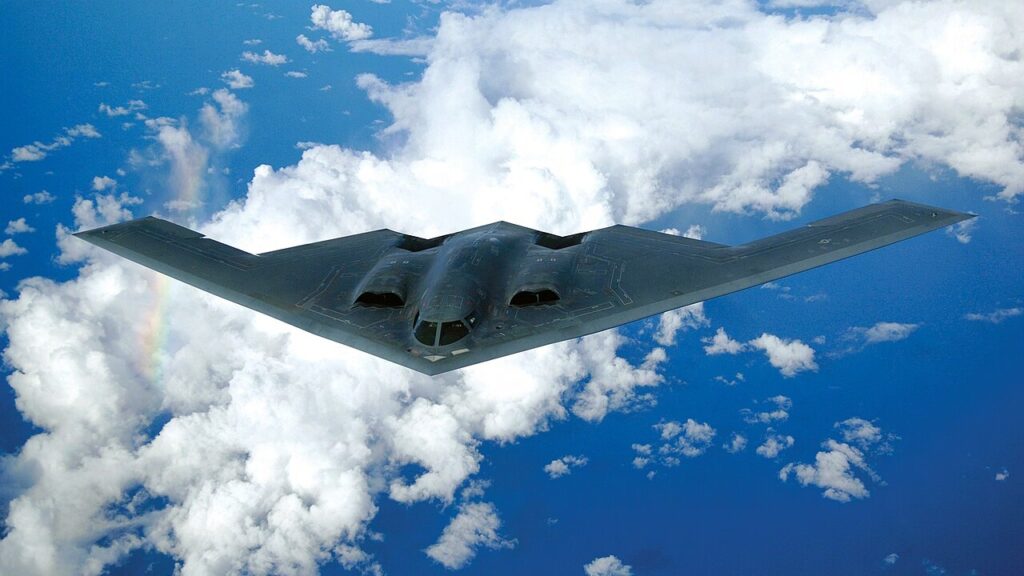
- Year Introduced: 1997 (USAF initial operational capability)
- Number Built: 21 (19 still operational)
- Length: 69 ft (21.0 m)
- Wingspan: 172 ft (52.4 m)
- Weight (MTOW): ~336,500 lb (152,200 kg)
- Engines: Four General Electric F118-GE-100 turbofans (~17,300 lbf thrust each)
- Top Speed: ≈630–650 mph (~1,010–1,045 km/h) / ~Mach 0.95
- Range: ~6,000 nmi (6,900 mi, 11,112 km) unrefueled (intercontinental with aerial refueling; global reach)
- Service Ceiling: ~50,000 ft (15,240 m)
- Loadout: Internal weapons bays; roughly ~40,000 lb (≈18,000 kg) of ordnance — nuclear and conventional mission sets (B61/B83 certified historically), precision-guided bombs (JDAM, SDB), and select standoff munitions depending on loadout
- Aircrew: 2 (pilot and mission commander)
You read that correctly. The B-2 Spirit stealth bomber costs over $2 billion per unit. Only 21 of the aircraft were ever produced, and because the program invested so much in the research and development necessary to field the world’s first (and still only operational) stealth bomber, the per-unit cost has remained truly astronomical—making the B-2 Spirit the most expensive aircraft ever made.
Designed by Northrop in the 1980s to carry both conventional and nuclear payloads over intercontinental distances, the B-2 was a strategic gamechanger when it arrived in the US inventory in 1997, capable of penetrating enemy air space without detection. Since the Spirit’s introduction, air defense systems have evolved, rendering the B-2 somewhat less effective in contested air space today than a generation ago—and making the sky-high operating costs hard to justify. Still, the bomber has been used to great effect in the modern era, most recently against Iran during “Operation Midnight Hammer” in June.
About the Author: Harrison Kass
Harrison Kass is a senior defense and national security writer at The National Interest. Kass is an attorney and former political candidate who joined the US Air Force as a pilot trainee before being medically discharged. He focuses on military strategy, aerospace, and global security affairs. He holds a JD from the University of Oregon and a master’s in Global Journalism and International Relations from NYU.
Image: Wikimedia Commons.












